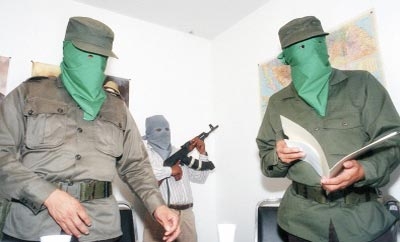Government sources have linked one of Mexico’s most prominent guerrilla organizations to a series of recent social protests, offering a window into the insurgents’ shifting modus operandi.
Earlier this month government sources leaked reports that the CNTE, an opposition teacher’s union responsible for a wave of recent and often violent protests around Mexico, had extensive links to the Popular Revolutionary Army (Ejercito Popular Revolucionario – EPR). The most specific instance is the May kidnapping of two children of a prominent businessman in Oaxaca, for which the government arrested three members of the CNTE (among 12 total) while alleging EPR participation in the crime.
On October 6, columnist Ricardo Aleman published an interview with Jefte Mendez Hernandez, an Oaxaca politician and a rival of the CNTE. Mendez Hernandez claimed that the links between the two groups date back several years, and that they finance their operations thanks in large part to kidnappings.
Reports have indicated similar ties between the EPR and other social protest movements, especially in Oaxaca. One is the Popular Assembly of the Peoples of Oaxaca, known as APPO for its initials in Spanish. The APPO led a series of protests in Oaxaca in 2006 that precipitated conflicts with federal authorities and led to a handful of deaths. The protests were in response to allegations of voter fraud made against then-Governor Ulises Ruiz, and members of the EPR later claimed to have helped organize the movement. The APPO continues to play a role in Oaxaca, staging demonstrations in support of the CNTE last month.
InSight Crime Analysis
The EPR’s alliances with organizations like the APPO and the CNTE represent a fundamental shift in their approach. While controversial, such groups are much closer to the mainstream of Mexican public life than the EPR traditionally has been.
In contrast, the EPR’s initial wave of activities during the 1990s killed a few dozen people, many of them soldiers in the army and other state officials. Some of the attacks, which were concentrated in Guerrero, Chiapas, and Oaxaca, appear to have been well coordinated militaristic operations. In 1997, for example, a series of ambushes of military convoys over a four-day period left five soldiers dead and three wounded.
SEE ALSO: EPR Profile
The EPR’s most famous moment in their recent history came in 2007, when it set off explosions in Tlaxcala, Veracruz, Queretaro, and Guanajuato, damaging gas pipelines owned by Pemex, Mexico’s state oil company. Launched in response to the alleged detention of two members of the guerrilla group, the attacks killed no one but disrupted the energy supply for thousands of homes and businesses across central Mexico.
The 2007 bombings marked the last operation that fit the profile of an outright insurgent group, and they provoked a wave of outcry. In addition to the familiar responses to the logic of left-wing attacks against public goods — essentially, knocking the pipelines offline hurt no one more than the poor that the EPR theoretically seeks to liberate — many Mexicans further questioned the timing of such spectacular attacks. They came just months after Osama bin Laden threatened to attack Mexico’s energy assets, and the last of the pipeline explosions went off on September 10. This gave the appearance of the EPR working to advance Al Qaeda’s agenda.
Since then, the EPR seems to have adjusted its strategy and its tactics. In making common cause with the APPO and the CNTE, the EPR has forsworn the flashy attacks. Instead, they wield their influence through protest movements, which permit them to have a more consistent (albeit indirect) role in the national debate than that granted by the odd explosion or attack against police. These protest movements are virulently opposed to the current political establishment, they often turn violent, and as noted above, are alleged to be supported by violent crimes like kidnapping. However, in supporting them, the EPR’s tactics no longer verge on terrorism.
While this development appears positive for Mexico’s public security, there is a downside: the collaboration with the EPR appears to radicalize the aforementioned groups, and distances them from their root motivations, which often enjoy wide support among the society at large. For instance, the CNTE first emerged in opposition to the hegemonic control and rampant corruption of the dominant teacher’s union, the SNTE. This is an ethos that many in Mexico continue to share, as is the APPO’s rejection of Ulises Ruiz’s and other fraudulent elections.
However, over the last few months, the CNTE has since grown into one of the most destabilizing political forces in Mexico, and it is allegedly deploying kidnapping rings to finance its existence. While it’s impossible to prove at this stage, it is difficult to separate their radicalization from their growing ties to the EPR. Moreover, if the EPR manages to integrate itself into the CNTE’s operations, it is capable of doing the same elsewhere, thereby expanding its influence. And though for Mexico it’s surely better not to have the EPR embracing guerrilla tactics, the price for this may be ever more radicalized social movements as the rebels gain access to a broader base of support.

